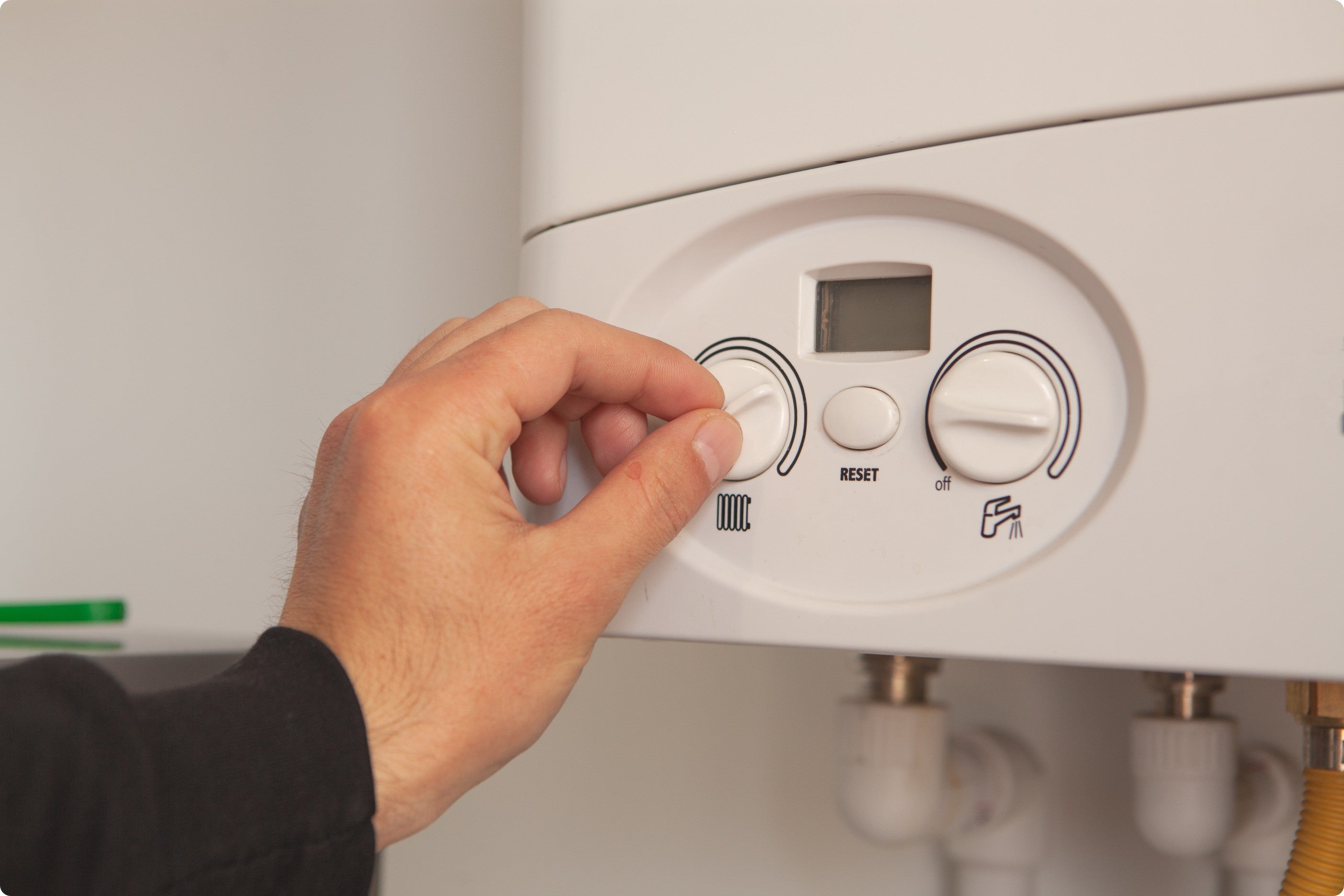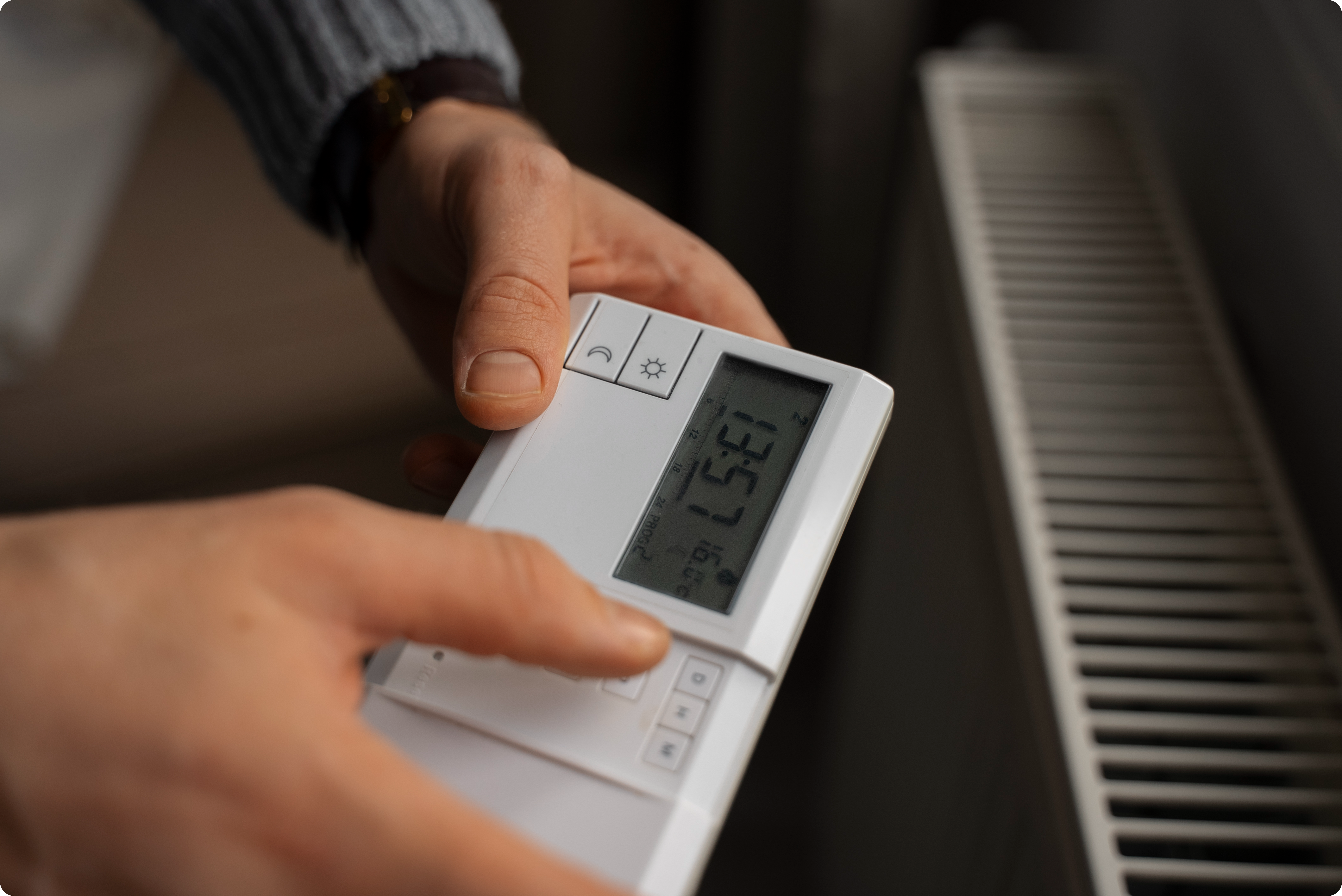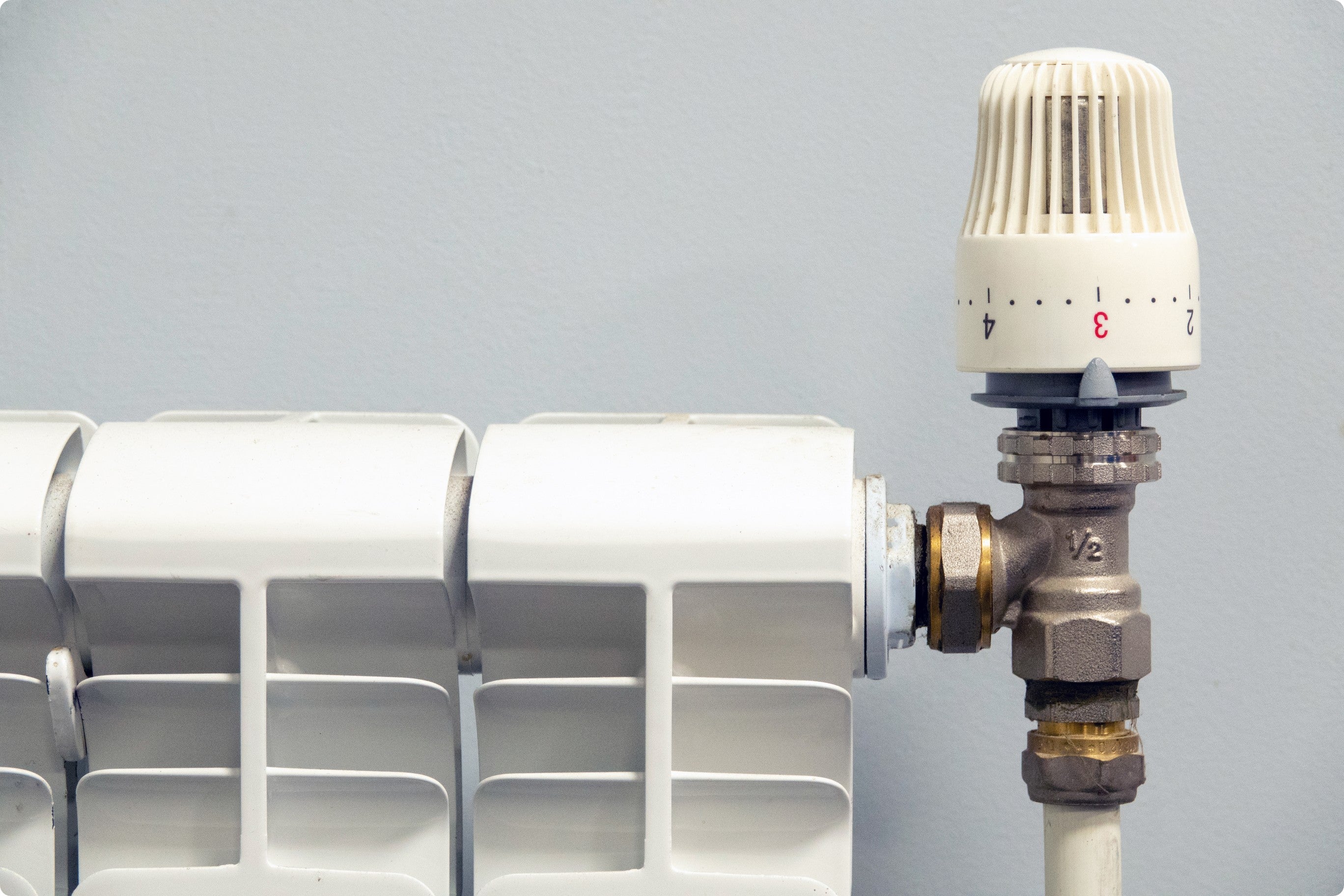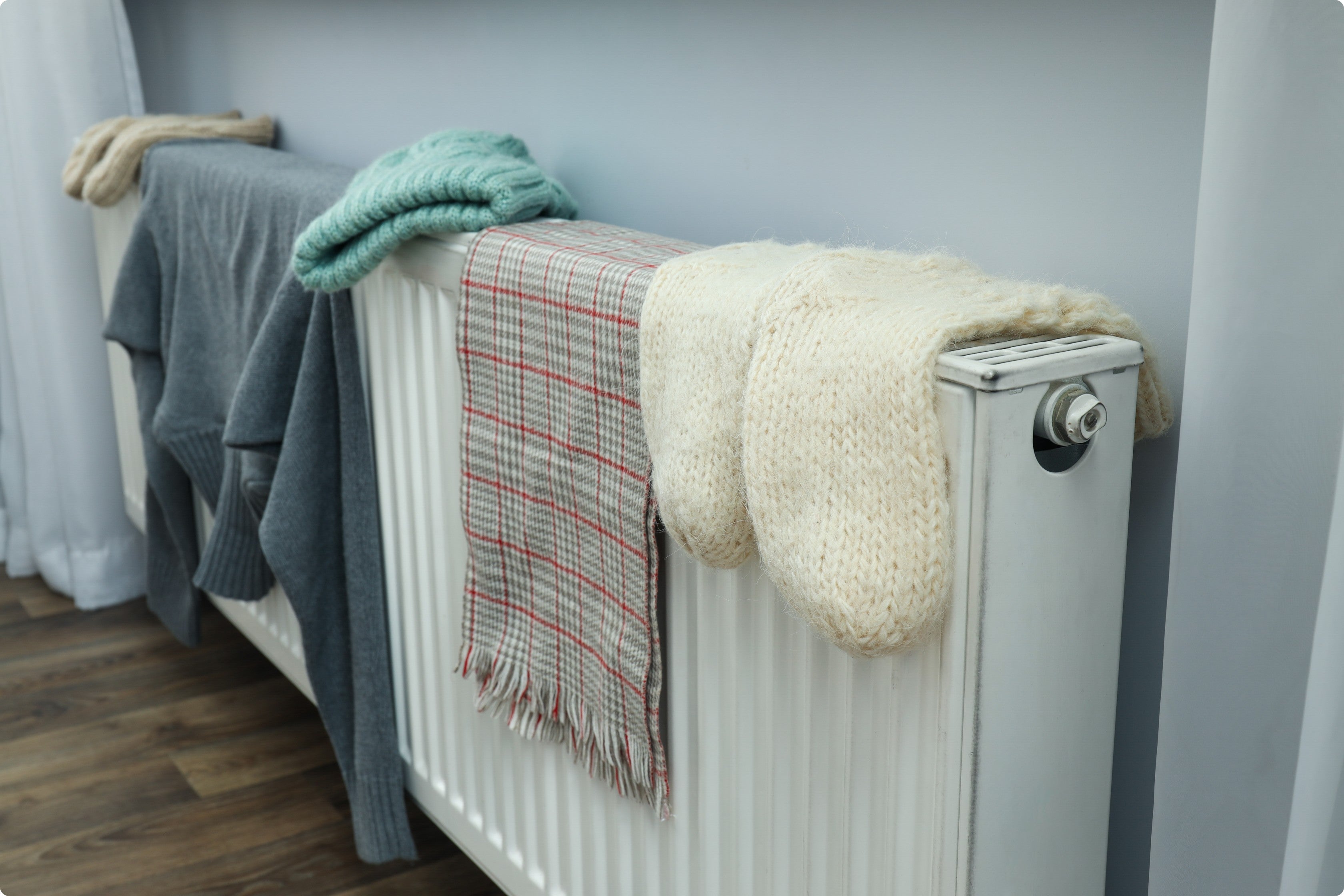With the weather changing and the energy bill price rise looming, many people are looking for ways to heat their homes for less this chilly season. In our article we’ll look at some ways to do this that you might not have considered before.
- Check the settings on your boiler
- Lower your thermostat a touch
- Get TRVs fitted
- Prevent draughts
- Bleed your radiators
- Don’t dry clothes on radiators
Check the settings on your boiler

When you got your boiler installed (or moved into your home) did you check the settings? Every boiler should have controls to control the temperature of your radiators and your hot water, whether these are an older style dials or an LED display.
It’s generally agreed that the optimum temperature is 60°c for your hot water and 70°c for your radiators. Anything over this is potentially just wasting energy and therefore money.
As well as this, some boilers will have an ‘eco’ mode. This means that your boiler won’t heat unless you need it to. You will have to wait for hot water out of the taps, you won’t be using gas unless you need to.
Lower your thermostat a touch

Similarly to lowering the temperature on your boiler, double check that you’re in the optimum heat range on your thermostats too. 18-21°c is widely regarded to be the perfect temperature in your home, but each degree colder you can manage means savings. It’s estimated at for each degree lower you have your heating set to, you could be saving around £65 a year.
As is the favourite mantra of many dads around the country, if you’re cold put on a jumper!
Get TRVs fitted
Thermostatic Radiator Valves are designed to give you greater control over the heat of a room. They self-regulate, which means when you put them on a setting they will automatically increase or restrict the water flow into your radiator to maintain the desired temperature.
TRVs are great because they allow you to control each room of your home individually, therefore saving on potential wasted energy.
Let’s say for example you have a living room where you spend most of your time, you like your bedroom to be colder to sleep in, and you have a spare room that is rarely used. Without TRVs, when your heating it turned on all of these rooms are being heated equally. However, once you have TRVs installed, you can set your living room to 5 to be cosy in the evening. Your bedroom can be set to 2 so you’re not sweaty while you sleep, and your spare room can be on frost protect (meaning it’s not being heated at all).
Prevent draughts
No matter how well insulated your home is, there will always be some heat lost to the outside. However, there are some steps you can take to minimise this as far as possible.
If you have gaps under your doors, either internal or external, you may be losing more heat than you think. A squishy cushion pushed up against the door can help to prevent cold draughts from stealing the warmth. You can also get adhesive tape to go around door edges to block up smaller gaps.
If your letter box is open to the outside it may also be losing a lot of heat, so you can get draught excluders that fit in there, too.
If you’re noticing draughts around window frames or other wall installations that open to outside, you may be able to easily prevent them by replenishing or replacing the silicone that seals the gap. If it’s in generally good condition, you can probably just top it up, but it may be better to remove and replace it.
Bleed your radiators

Air can sometimes get into your central heating system, which can settle in your radiators. This leads them to be less efficient. As you would expect, a large pocket of air in your radiator means that it doesn’t get as hot as it should, which in turn means you may find yourself running your heating for longer to reach your desired temperature.
To bleed your radiators, you simply need a radiator key and a cloth or rag. Holding the cloth underneath, turn the key anticlockwise in the valve until the air starts to leak out. Don’t open it too much, and wait until a little water dribbles out and then close it again by turning it clockwise.
Don’t dry clothes on radiators

When the weather turns it may not be an option for you to dry clothes outside anymore, but running your tumble dryer (if you have one) can be a costly expense. Many people therefore choose to dry clothes on their radiators, but did you know this can make your heating less efficient?
Covering your radiators with clothes stops the heat from reaching the air to warm your room. This is true whether or not the clothes are dry. If you need to dry your clothes indoors, put them on an airer close to the radiator, rather than hanging over it directly.
Drying clothes indoors can also cause to excess moisture in the air, which can lead to damp and mould. To prevent this and keep your humidity in safe ranges, you could consider a dehumidifier. Many even have a specific laundry mode for drying clothes more efficiently.
Check out our other heating related articles for more information!








 Portable Air Conditioners
Portable Air Conditioners
 Evaporative Air Coolers
Evaporative Air Coolers
 Wall Mounted Air Conditioning Units
Wall Mounted Air Conditioning Units
 Commercial Cooling
Commercial Cooling
 Ceiling Cassette Air Conditioning
Ceiling Cassette Air Conditioning
 Desk Fans
Desk Fans
 Pedestal Fans
Pedestal Fans
 Floor Fans
Floor Fans
 Tower Fans
Tower Fans
 DC Fans
DC Fans
 Air Circulators
Air Circulators
 Inline Fans
Inline Fans
 Kitchen Extractor Fans
Kitchen Extractor Fans
 Bathroom Extractor Fans
Bathroom Extractor Fans
 Commercial Extractor Fans
Commercial Extractor Fans
 Shower Extractor Fans
Shower Extractor Fans
 Silent Extractor Fans
Silent Extractor Fans
 Heat Recovery Extractor Fans
Heat Recovery Extractor Fans
 PIV & Whole House Ventilation
PIV & Whole House Ventilation
 Extractor Fan Accessories
Extractor Fan Accessories
 Extractor Fan Controllers
Extractor Fan Controllers
 Home Dehumidifiers
Home Dehumidifiers
 Drying Clothes Dehumidifiers
Drying Clothes Dehumidifiers
 Low Energy Dehumidifiers
Low Energy Dehumidifiers
 Compressor Dehumidifiers
Compressor Dehumidifiers
 Desiccant Dehumidifiers
Desiccant Dehumidifiers
 Commercial Dehumidifiers
Commercial Dehumidifiers
 Swimming Pool Dehumidifiers
Swimming Pool Dehumidifiers
 Wall Mounted Dehumidifiers
Wall Mounted Dehumidifiers
 Dehumidifier Accessories
Dehumidifier Accessories
 Humidifiers & Air Purifiers
Humidifiers & Air Purifiers
 Panel Heaters
Panel Heaters
 Fan Heaters
Fan Heaters
 Patio Heaters
Patio Heaters
 Storage Heaters
Storage Heaters
 Towel Rails
Towel Rails
 Underfloor Heating
Underfloor Heating



 Electric Fires
Electric Fires
 Time Controllers
Time Controllers
 Ducting Kits
Ducting Kits
 Internal Grilles
Internal Grilles
 External Grilles
External Grilles
 Ducting Hose
Ducting Hose
 Ducting Clamps
Ducting Clamps
 Ducting Connectors
Ducting Connectors

 Electric Radiators
Electric Radiators
 Oil Filled Radiators
Oil Filled Radiators
 Oil Free Radiators
Oil Free Radiators
 Designer Radiators
Designer Radiators
 Water Boilers
Water Boilers
 Under Sink Water Heaters
Under Sink Water Heaters
 Over Sink Water Heaters
Over Sink Water Heaters
 Unvented Water Heaters
Unvented Water Heaters
 Instant Water Heaters
Instant Water Heaters
 Boiling Water Taps
Boiling Water Taps
 Hand Wash Units
Hand Wash Units
 Air Curtains
Air Curtains
 Commercial Wall Heaters
Commercial Wall Heaters
 Returned Air Conditioners
Returned Air Conditioners
 Returned Fans
Returned Fans
 Returned Dehumidifiers
Returned Dehumidifiers
 Returned Heaters
Returned Heaters
